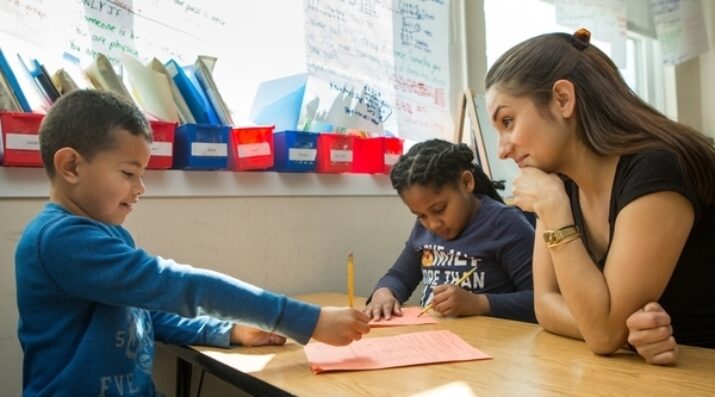What’s Wrong with the Four Day School Week?
Topics

When educators design and create new schools, and live next gen learning themselves, they take the lead in growing next gen learning across the nation. Other educators don’t simply follow and adopt; next gen learning depends on personal and community agency—the will to own the change, fueled by the desire to learn from and with others. Networks and policy play important roles in enabling grassroots approaches to change.
Instead of four-day school weeks, many schools and districts are using creative and effective strategies that improve teacher working conditions while expanding authentic learning opportunities.
In Mississippi, a school district recently converted their school week to four days, and provided inexpensive child care for those who needed it on the fifth, thinking this would address their challenges with recruiting and retaining teachers. An article on CBS News put it this way:
“Dale Herl, superintendent of the Independence [Mississippi] School District, and his staff have spent months planning for this year's significant calendar change. His district is the largest in the state to move to a four-day schedule. To comply with state requirements for instructional time, which determines how school calendars are structured, the district will add 35 extra minutes onto each day. ‘So the instructional minutes will be almost exactly the same,’ Herl explained.”
The Independence School District is not alone in adopting this approach, or in thinking it will solve the problem of teacher retention. As the CBS article puts it, “Hundreds of districts across the country have moved to adopt the alternative weekly schedule in recent years.” Sadly, this response to the “teacher shortage” (and see below for my critique of that term) is like putting old wine in old bottles that you have chopped up and rearranged to seem like new bottles, but they are just worse versions of the old ones.

Credit: Wonderful DIY
A recent policy brief from the Learning Policy Institute (LPI) states: “To handle the shortages, schools have increased class sizes, canceled course offerings, added duties to the responsibilities of existing teachers, and hired underqualified individuals to fill the positions—all of which undermine students’ learning.” Instead of these reactive and unthoughtful approaches that not only undermine student learning, but have the (one must think!) unintended consequence of making it less likely that teachers will stay in the profession, LPI offers seven recommendations:
- Increase educators’ net compensation through tax credits, housing subsidies, and salary incentives.
Strengthen recruitment by making teacher preparation debt-free.
- Support improved preparation by expanding high-retention pathways into teaching.
- Provide high-quality mentoring for all beginning teachers.
- Increase investments that enable educators to expand and share expertise.
- Incentivize the redesign of schools to support teaching and learning.
- Rethink school accountability.
This seems like a good start. But there is more. Before this year’s iteration of responses to the unsustainability of the teaching profession, I wrote a blog article about getting rid of the terms, “teachers shortage,” “teacher pipeline,” and “teacher workforce” altogether, because of the negative meanings, bad habits, and lack of any systemic or root cause analysis of the problem implied by those terms. Summarizing a recently published policy brief from the National Education Policy Center (NEPC) and other reports reviewing findings about teacher retention, I stated:
“Salary, although important, turns out not to be the only reason that teachers cite for their dissatisfaction with the career, NEPC reports, and other reports agree. NEPC describes as equally important, the ‘...working conditions in schools. Especially important is the amount of voice teachers have into key decisions in their schools. [Richard Ingersoll and Tuan Nguyen] recommend policymakers and district leaders incorporate teachers’ input into the decision-making process to improve retention. Moreover, teachers have valuable insights to offer, and policy changes would be better informed if they considered the experiences of educators.’ It turns out that the culture of a school is highly significant when it comes to the early experiences of newer teachers and the decisions they as well as mid-career teachers make about staying in the profession. In many urban schools, fully two-thirds of new teachers leave the profession by the end of their third year of teaching. Currently, increasingly large numbers are leaving at the mid-career level.”
What to do? It turns out there are really creative and effective strategies already being used in many schools and districts that actually improve teacher working conditions while at the same time expand authentic learning opportunities for our young learners. What are they and why aren’t more schools and districts making these more thoughtful and responsive changes?
Teachers in the U.S. spend more hours teaching, and have fewer hours to prepare lessons, collaborate to share practices with and learn from each other, and grade student work, than teachers in most other OECD nations (nations with similar levels of economic development that we usually compare ourselves to educationally), a discrepancy well explained in this Vox video. And yet, various approaches to the organization of school are emerging that provide creative ways we could decrease teachers’ time with students, increase both collaborative and individual planning and grading time, and also provide students with powerful learning outside the regular classroom that effectively extends their learning time, not shortens it.
For example, imagine a five day school week where students came to school buildings for only four of those days. Because of such arrangements as Community Schools or College and Career Pathways, those students spend their fifth day out in the community learning in other kinds of settings. They go to local community colleges for dual enrollment programs. They go to the buildings of community-based organizations for extended learning opportunities that involve integrated student supports, expanded and enriched learning time and opportunities, active family and community engagement, etc. And they go to the workplaces of local businesses and industries for work-based learning, internships, industry certification, or apprenticeship experiences. These arrangements spread the educational responsibilities across the community and give teachers more time to do the essential planning and response to student work that they normally do in the evenings and on weekends. And these approaches do not involve shortening the work week by lengthening the school day in a kind of magical thinking that this would somehow increase teacher retention.
This is just one creative strategy to address the challenges of an unsustainable profession for American teachers. Many others exist too.
It is only a lack of imagination and lack of awareness that these possibilities already exist that keep school happening “the way it’s supposed to be” (that is, the way we experienced it when we were students). That does not have to be the case. Let’s get rid of those old bottles and short-sighted solutions like four-day school weeks. And while we are at it, let’s dump the old wine of 20th century schooling too.
Photo at top by Allison Shelley/The Verbatim Agency for EDUimages, CC BY-NC 4.0.




